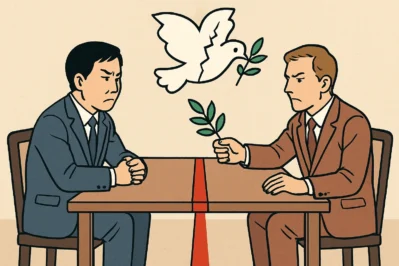Ceasefire Talks: Mastering Diplomatic Korean
Hello! This is Maeil Hangul, here to upgrade your Korean skills to the highest level!
Today, we are moving beyond everyday conversation and stepping into the world of international relations. We’ll learn the essential Korean vocabulary and expressions used when negotiating a ceasefire between two warring parties. In today’s interconnected world, understanding the language of diplomacy you hear on the news is a crucial skill for any advanced learner. Mastering these terms will not only allow you to comprehend complex news reports but also to discuss global issues with sophistication in Korean.
Core Diplomatic Expressions
Here are five key expressions you absolutely need to know when discussing high-stakes negotiations.
1. 휴전 협상 (Hyujeon Hyeopsang)
* Pronunciation: [hyu-jeon hyeop-ssang]
* English Meaning: Ceasefire negotiation; truce talks.
* Detailed Explanation: This is the foundational term. 휴전 (hyujeon) means a temporary cessation of hostilities (a truce or ceasefire), and 협상 (hyeopsang) means negotiation. This phrase refers to the formal talks aimed at stopping the fighting. It’s a standard, formal term used in news and official documents.
2. 상호주의 원칙 (Sanghojuui Wonchik)
* Pronunciation: [sang-ho-ju-ui won-chik]
* English Meaning: The principle of reciprocity.
* Detailed Explanation: This is a core concept in any negotiation. It refers to the agreement that any concession or action by one side will be met with an equivalent concession or action from the other. 상호 (sangho) means “mutual,” and 원칙 (wonchik) means “principle.” You’ll often hear this when one side states, “We will act based on the principle of reciprocity.”
3. 양보할 수 없는 선 (Yangbohal Su Eomneun Seon)
* Pronunciation: [yang-bo-hal ssu eom-neun seon]
* English Meaning: A non-negotiable line; a red line.
* Detailed Explanation: Literally translating to “a line that cannot be conceded,” this phrase powerfully communicates a party’s bottom line. 양보하다 (yangbohada) means to concede or yield. This expression is used to firmly state a condition that is absolutely essential and cannot be compromised.
4. 교착 상태에 빠지다 (Gyochak Sangtae-e Ppajida)
* Pronunciation: [gyo-chak ssang-tae-e ppa-ji-da]
* English Meaning: To reach a stalemate; to fall into a deadlock.
* Detailed Explanation: This is a common phrase used to describe negotiations that have stopped progressing because neither side is willing to compromise further. 교착 상태 (gyochak sangtae) means deadlock or stalemate, and 빠지다 (ppajida) means “to fall into.” It perfectly captures the feeling of being stuck.
5. 신뢰 구축 조치 (Silloe Guchuk Jochi)
* Pronunciation: [sin-lloe gu-chuk jo-chi]
* English Meaning: Confidence-building measures (CBMs).
* Detailed Explanation: This is a standard diplomatic term. It refers to a series of actions taken to reduce tension and build trust between two opposing sides before or during major negotiations. Examples include exchanging military data or establishing communication hotlines. 신뢰 (silloe) is trust, 구축 (guchuk) is building or establishment, and 조치 (jochi) are measures.
Example Dialogue: At the Negotiating Table
Let’s see how these expressions are used in a realistic negotiation scenario between Diplomat A and Diplomat B.
A: 우리 측은 즉각적인 휴전 협상의 재개를 제안합니다. 단, 모든 논의는 상호주의 원칙에 입각해야 합니다.
(Our side proposes the immediate resumption of ceasefire negotiations. However, all discussions must be based on the principle of reciprocity.)
B: 원칙에는 동의합니다. 하지만 국경선에서 모든 병력을 철수하는 것은 우리에게 양보할 수 없는 선입니다.
(We agree on the principle. But the complete withdrawal of all forces from the border is a non-negotiable line for us.)
A: 그 조건은 현재로서는 받아들이기 어렵습니다. 이대로라면 대화가 교착 상태에 빠질 수밖에 없습니다.
(That condition is difficult to accept at present. If this continues, the talks will inevitably reach a stalemate.)
B: 그렇다면, 본 협상에 앞서 몇 가지 신뢰 구축 조치부터 시작하는 것은 어떻습니까? 예를 들어, 상호 감시 초소를 설치하는 것부터 말입니다.
(In that case, how about we start with a few confidence-building measures before the main negotiations? For instance, starting with the installation of mutual observation posts.)
Cultural Tip & Deeper Insight
When discussing ceasefires in a Korean context, it’s crucial to understand the difference between 휴전 (hyujeon) and 정전 (jeongjeon).
- 휴전 (Hyujeon), as we learned, is a general term for a ceasefire or truce, often implying a temporary halt to fighting.
- 정전 (Jeongjeon) refers to an armistice, which is a more formal, long-term agreement to stop fighting, as codified in an armistice agreement (정전 협정, jeongjeon hyeopjeong).
The Korean War, for example, ended not with a peace treaty but with the Korean Armistice Agreement (한국 정전 협정). Therefore, technically, the two Koreas are still in a state of 정전, not permanent peace. When you watch Korean news about inter-Korean relations, you will frequently hear discussions about actions that might violate the 정전 협정. Understanding this distinction will show a truly advanced command of both the language and the cultural-historical context of the Korean peninsula.
Let’s Review and Practice!
Fantastic work today! We’ve covered some very advanced and powerful vocabulary used in the world of diplomacy. You learned how to discuss ceasefire talks, state non-negotiable terms, and describe a deadlock.
Now, let’s put your knowledge to the test.
- Fill in the Blank: If both sides refuse to compromise on key issues, the negotiations will likely _______________.
- Sentence Building: Imagine you are a diplomat. Write one sentence in Korean using 신뢰 구축 조치 to make a proposal to the other side.
Leave your answers in the comments below using the expressions we learned today! We’d love to see you put your new skills into practice. Keep up the great work






